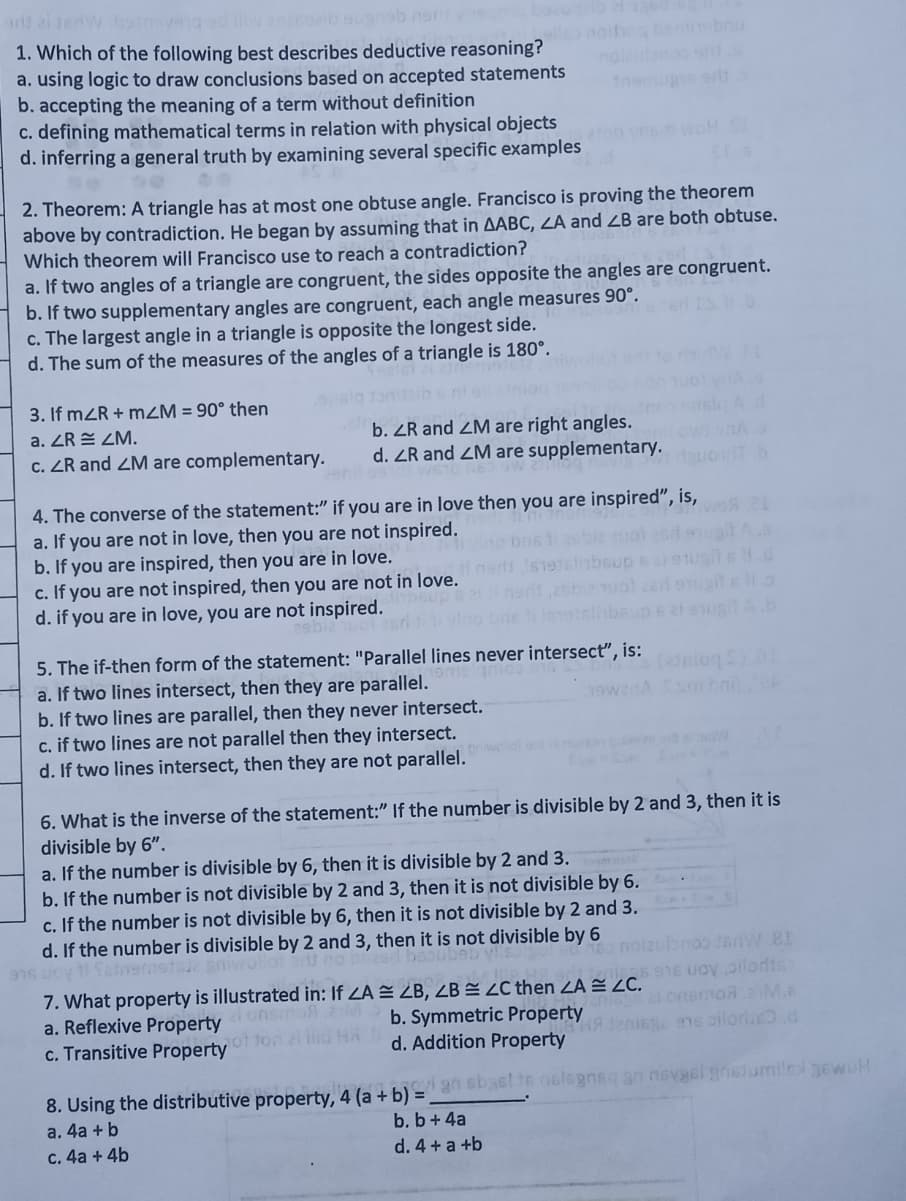1. Which of the following best describes deductive reasoning? a. using logic to draw conclusions based on accepted statements b. accepting the meaning of a term without definition c. defining mathematical terms in relation with physical objects d. inferring a general truth by examining several specific examples
1. Which of the following best describes deductive reasoning? a. using logic to draw conclusions based on accepted statements b. accepting the meaning of a term without definition c. defining mathematical terms in relation with physical objects d. inferring a general truth by examining several specific examples
Elementary Geometry For College Students, 7e
7th Edition
ISBN:9781337614085
Author:Alexander, Daniel C.; Koeberlein, Geralyn M.
Publisher:Alexander, Daniel C.; Koeberlein, Geralyn M.
Chapter1: Line And Angle Relationships
Section1.4: Relationships: Perpendicular Lines
Problem 12E: In Exercise 11 and 12, provide the missing statements and reasons. Given: 12;34 s 2 and 3 are...
Related questions
Question
1b. Kindly answer this. Answer only. No solution needed

Transcribed Image Text:ard ai ienw baineve
ben bnu
1. Which of the following best describes deductive reasoning?
a. using logic to draw conclusions based on accepted statements
b. accepting the meaning of a term without definition
c. defining mathematical terms in relation with physical objects
d. inferring a general truth by examining several specific examples
nemugis s
2. Theorem: A triangle has at most one obtuse angle. Francisco is proving the theorem
above by contradiction. He began by assuming that in AABC, ZA and ZB are both obtuse.
Which theorem will Francisco use to reach a contradiction?
a. If two angles of a triangle are congruent, the sides opposite the angles are congruent.
b. If two supplementary angles are congruent, each angle measures 90°.
c. The largest angle in a triangle is opposite the longest side.
d. The sum of the measures of the angles of a triangle is 180°.
3. If mZR + mZM = 90° then
b. ZR and ZM are right angles.
d. ZR and ZM are supplementary.
a. ZR E ZM.
c. ZR and ZM are complementary.
4. The converse of the statement:" if you are in love then you are inspired", is,
a. If you are not in love, then you are not inspired.
b. If you are inspired, then you are in love.
c. If you are not inspired, then you are not in love.
d. if you are in love, you are not inspired.
2sbie uol 2
boup s ar911
el sug A.b
5. The if-then form of the statement: "Parallel lines never intersect", is:
a. If two lines intersect, then they are parallel.
b. If two lines are parallel, then they never intersect.
c. if two lines are not parallel then they intersect.
d. If two lines intersect, then they are not parallel.
(nion )t
6. What is the inverse of the statement:" If the number is divisible by 2 and 3, then it is
divisible by 6".
a. If the number is divisible by 6, then it is divisible by 2 and 3.
b. If the number is not divisible by 2 and 3, then it is not divisible by 6.
c. If the number is not divisible by 6, then it is not divisible by 2 and 3.
d. If the number is divisible by 2 and 3, then it is not divisible by 6
5 916 uoy pilodis
7. What property is illustrated in: If ZA ZB, ZB = ZC then ZA = ZC.
el onsmo.2M
lonsmon M.R
a. Reflexive Property
c. Transitive Property
b. Symmetric Property
d. Addition Property
eni 9ns oiloriuro.d
16q an nevgcl grnslumile gewuH
8. Using the distributive property, 4 (a + b) = _
a. 4a +b
c. 4a + 4b
b. b+ 4a
d. 4 + a +b
Expert Solution
This question has been solved!
Explore an expertly crafted, step-by-step solution for a thorough understanding of key concepts.
This is a popular solution!
Trending now
This is a popular solution!
Step by step
Solved in 2 steps

Recommended textbooks for you

Elementary Geometry For College Students, 7e
Geometry
ISBN:
9781337614085
Author:
Alexander, Daniel C.; Koeberlein, Geralyn M.
Publisher:
Cengage,

Elementary Geometry for College Students
Geometry
ISBN:
9781285195698
Author:
Daniel C. Alexander, Geralyn M. Koeberlein
Publisher:
Cengage Learning

Elementary Geometry For College Students, 7e
Geometry
ISBN:
9781337614085
Author:
Alexander, Daniel C.; Koeberlein, Geralyn M.
Publisher:
Cengage,

Elementary Geometry for College Students
Geometry
ISBN:
9781285195698
Author:
Daniel C. Alexander, Geralyn M. Koeberlein
Publisher:
Cengage Learning